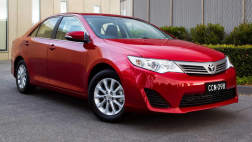Once you dismiss the differences in the bodywork and the individual tuning of the suspension, it’s obvious they come from the same rootstock.
It’s the same with the Kia Sportage and Hyundai ix35, and just about everything else in the two brands’ showrooms. Kia has its Soul and Grand Carnival, and Hyundai has the Veloster and coming Genesis luxury sedan but the mainstream stuff is identical.
That’s no surprise. The companies are part of the same giant South Korean industrial complex, which manufactures everything up to supertankers. Hyundai and Kia began separately and the latter is actually the older company, with a history running back to 1944. When it ran into trouble in the Asian economic meltdown it was brought into the Hyundai family with a bailout package that has also included shared development and basic model plans.
In Australia, Hyundai and Kia are take-no-prisoners rivals but in some countries they are bundled together. In Canada, Hyundai-Kia rates second on the sales charts and is only trumped by Chrysler. If you did the same thing in Australia, the South Korean combination would also rate second overall. Hyundai was fourth in the 2013 rankings behind Toyota, Holden and Mazda with sales of 97,006 vehicles.
When you tip in the extras from Kia, the number jumps to 126,874, a total eclipsed only by the 214,630 of Toyota. Combine i30 and Cerato tallies, to 36,367, and they’re still in fourth - but they move the total further ahead of Commodore and only 3000 short of the third-placed Toyota HiLux.
But don’t expect anyone at either Kia or Hyundai in Australia - the red and the blue teams, as they are known, because of their corporate colours - to push for any sort of alliance. “The two companies are set up to compete,” says Kia spokesman Kevin Hepworth.
Part of that competition led Kia to push strongly for a local “personality” in its cars, something provided by engineering and suspension guru Graeme Gambold. It’s no surprise that Hyundai is now doing something similar, with a different feel.
Hyundai and Kia are not alone on the South Korean front. Daewoo cars conveniently fly Holden badges and Ssangyong the country third, behind Japan and Thailand. That places Thailand as a photocopy country producing runs of cars designed somewhere else - think the excellent Ford Ranger from Australia.
On the other hand, South Korea pushes hard for class and quality and now builds better Japanese cars than Japan, in terms of value, quality and reliability. Kia is also creating a reputation for great design and Hyundai is aiming for the big breakthrough, a worthy luxury car, with the Genesis that lands here later in the year.
Both are also driving great value for Australian car buyers. So it’s probably a good thing for customers - and their rivals - that the red and blue teams regard themselves as deadly rivals and not just one brand with two showrooms.
Kia Sportage
Price: from $25,490
Rating: 3.5/5
Engine: 2.0-litre 4-cyl 122kW/197Nm, 2.0-litre 4-cyl turbo diesel, 135kW/392Nm
Transmission: 5-speed/6-speed man/auto; FWD
Thirst: from 7.2L/100km
The lowdown: One of the first Kia models to benefit from Australian suspension tuning and a Carsguide favourite as a result. It’s been overtaken by the Mazda CX-5 and Subaru Forester but is still roomy, well equipped, excellent value (on the ownership front too) and a good drive.
Hyundai i30
Price: from $20,990
Rating: 4/5
Engine: 1.6-litre 4-cyl, 107kW/175Nm
Transmission: 6-speed man/auto; FWD
Thirst: from 6.8L/100km
The lowdown: Recent suspension improvements mean the i30 drives even better, although its age means it rates third in class behind the VW Golf and Mazda3. The i30 has become a new-age Corolla, the car you recommend to people who just want trouble-free, cost-effective motoring. It’s better than the Toyota and a winner with its five-year warranty and service package.
Hyundai Santa Fe
Price: from $37,990
Rating: 3.5/5
Engine: 2.4-litre 4-cyl, 141kW/242Nm, 2.2-litre 4-cyl turbo diesel, 145kW/421Nm
Transmission: 6-speed man/auto; AWD
Thirst: from 6.5L/100km
THE LOWDOWN: The Santa Fe is tough to toss on the value front, with the seven-seater capacity that’s essential for a lot of families. It’s now a generation newer under the skin than its Kia Sorento rival, which means it drives better and is also quieter. It’s a reversal of the Sportage-ix35 match-up, where Carsguide prefers the Kia. Customers are the real winners.
SECOND-HAND
The bland but efficient Hyundai Getz has taken over from the Toyota Corolla as the Carsguide choice for first-car buyers. The boxy little baby ticks all the right boxes, from price to economy, and we rarely hear of mechanical problems. They were sold in huge numbers and that means good value as a used car.
Hyundai first made its name on the second-hand scene with the jelly bean-shaped Excel, although it was never a great car, and the Getz is building from that base.
There’s a big advantage for used buyers - the five-year warranty and affordable servicing mean Getz new-car buyers have been more likely to give their cars the care and attention that pays off for subsequent owners.
This reporter is on Twitter: @PaulWardGover





.jpg)
.jpg)

.jpg)


.jpg)

.jpg)


.jpg)



.jpg)






